Aerial SfM–MVS Visualization of Surface Deformation along Folds during the 2024 Noto Peninsula Earthquake (Mw7.5)
Abstract
:1. Introduction
2. Survey
2.1. Geology
2.2. Geomorphology
3. Materials and Methods
3.1. Pre-Earthquake DTM (2022DTM)
3.2. Post-Earthquake DSM (2024DSM)
3.2.1. SfM Point Cloud and DSM Generation
3.2.2. Ground Control Point (GCP) Assignment
3.2.3. Orthomosaic Generation
3.3. Pre-Earthquake Historical DSM (1967DSM)
3.3.1. SfM Point-Cloud and DSM Generation
3.3.2. Ground Control Point (GCP) Assignment
3.3.3. Orthomosaic Generation
3.4. DEMs of Difference (DoDs)
4. Results
4.1. Regional Characteristics of Surface Deformation
4.2. Characteristics of the Central Area
4.2.1. Eastern Half of the Central Area (Eastern Part of the Naka Area of Wakayama Town)
4.2.2. Western Half of the Central Area (Western Part of the Naka Area of Wakayama Town)
4.2.3. Middle Part of the Central Section (Central Part of the Naka Area of Wakayama Town)
4.3. Characteristics of the Western Part (the Munesue and Kamikuromaru Areas of Wakayama Town)
4.4. Characteristics of Surface Deformation in the Eastern Area (the Nobutake Area of Wakayama Town)
5. Discussion
5.1. Causes of Surface Deformation
5.2. Advantages of Aerial Photographs and SfM–MVS in Preliminary Surveys
5.3. Location Accuracy of GCPs Immediately after the Earthquake
5.4. Removal of Systematic Errors
5.5. Cautions for Deciphering the DoD
6. Conclusions
Author Contributions
Funding
Data Availability Statement
Acknowledgments
Conflicts of Interest
References
- Japan Meteorological Agency. JMA CMT Solution. 2024. Available online: https://www.data.jma.go.jp/eqev/data/mech/cmt/fig/cmt20240101161022.html (accessed on 30 July 2024). (In Japanese)
- Headquarters for Earthquake Research Promotion. Evaluation of the 2024 Noto Peninsula Earthquake. 9 February 2024. Available online: https://www.static.jishin.go.jp/resource/monthly/2024/20240101_noto_3.pdf (accessed on 30 July 2024). (In Japanese)
- Geospatial Information Authority of Japan. Crustal Deformation Associated with the 2024 Noto Peninsula Earthquake Based on Analysis of “Daichi-2” Observation Data. 19 January 2024. Available online: https://www.gsi.go.jp/uchusokuchi/20240101noto_insar.html (accessed on 30 July 2024). (In Japanese)
- Inoue, T.; Okamura, Y. Explanatory Notes of 1:200,000 Marine Geological Map Around the Northern Part of Noto Peninsula. Seamless Geoinformation of Coastal Zone “Northern Coastal Zone of Noto Peninsula”. 26 February 2010. Available online: https://www.gsj.jp/data/coastal-geology/GSJ_DGM_S1_2010_01_b.pdf (accessed on 30 July 2024).
- Okamura, Y. Distribution of Active Faults in Japan Sea and Future Issues. Zisin 2019, 71, 185–199, (In Japanese with English Abstract). [Google Scholar] [CrossRef]
- Japan Coast Guard. Survey of Seafloor Topography Related to the 2024 Noto Peninsula Earthquake. 2024. Available online: https://www1.kaiho.mlit.go.jp/jishin/meeting/398chosa.pdf (accessed on 30 July 2024). (In Japanese)
- Okamura, Y.; Ogami, T.; Inoue, T.; Sato, T.; Arimoto, J. Report on the Urgent Investigation of the 2024 Noto Peninsula Earthquake (Displacement of Submarine Active Faults Associated with the 2024 Noto Peninsula Earthquake). 2024. Available online: https://www.gsj.jp/hazards/earthquake/noto2024/noto2024-10.html (accessed on 30 July 2024). (In Japanese).
- Geological Survey of Japan, AIST. Seamless Digital Geological Map of Japan V2 1:200,000, Original Edition. 2023. Available online: https://gbank.gsj.jp/seamless/ (accessed on 14 May 2024).
- Yoshikawa, T.; Kano, K.; Yanagisawa, Y.; Komazawa, M.; Joshima, M.; Kikawa, E. Geology of the Suzumisaki, Noto-iida and Hōryūzan District; Quadrangle Series; 1:50,000; Geological Survey of Japan, AIST: Tsukuba, Japan, 2002; p. 76, (In Japanese with English abstract 4p). [Google Scholar]
- Ishiguro, S.; Kumahara, Y.; Goto, H.; Nakata, T.; Matsuta, N.; Sugito, N.; Hirouchi, D.; Watanabe, M.; Sawa, H.; Suzuki, Y. Evaluation of high-resolution digital surface models of surface rupture associated with the 2014 Kamishiro Fault Earthquake, Central Japan, using unmanned aerial vehicle photography and SfM-MVS analysis. J. Remote Sens. Soc. Jpn. 2016, 36, 107–116, (In Japanese with English Abstract). [Google Scholar] [CrossRef]
- Yamazaki, F.; Kubo, K.; Tanabe, R.; Liu, W. Damage assessment and 3d modeling by UAV flights after the 2016 Kumamoto, Japan earthquake. In Proceedings of the 2017 IEEE International Geoscience and Remote Sensing Symposium (IGARSS), Fort Worth, TX, USA, 26 July 2017; pp. 3182–3185. [Google Scholar]
- Andreuttiova, L.; Hollingsworth, J.; Vermeesch, P.; Mitchell, T.M.; Bergman, E. Revisiting the 1959 Hebgen Lake earthquake using optical image correlation; new constraints on near-field 3D ground displacement. Geophys. Res. Lett. 2022, 49, e2022GL098666. [Google Scholar] [CrossRef]
- Delano, J.E.; Howell, A.; Stahl, T.A.; Clark, K. 3D Coseismic surface displacements from historical aerial photographs of the 1987 Edgecumbe Earthquake, New Zealand. J. Geophys. Res. Solid Earth 2022, 127, e2022JB024059. [Google Scholar] [CrossRef]
- Yoshida, K. Linear Surface Deformation with Vertical Displacement Appeared in Wakayama Town, Suzu City, Ishikawa Prefecture (Preliminary Report). 2024. Available online: https://www.gsi.go.jp/common/000254854.pdf (accessed on 30 July 2024). (In Japanese)
- Shirahama, Y.; Ishiyama, T.; Tateishi, R.; Yasue, K. Surface Ruptures Appeared along the Wakayama-Gawa River Associated with 2024 Noto Peninsula Earthquake (Preliminary Report). 2024. Available online: https://www.eri.u-tokyo.ac.jp/news/20465/ (accessed on 30 July 2024). (In Japanese).
- Yoshimi, M.; Maruyama, T. Report on the Urgent Investigation of the 2024 Noto Peninsula Earthquake (Field Survey of Land Surface Deformation Appearing on Land). 2024. Available online: https://www.gsj.jp/hazards/earthquake/noto2024/noto2024-09.html (accessed on 30 July 2024). (In Japanese).
- Ishida, S. The Cenozoic Strata of Noto, Japan. Mem. Coll. Sci. Univ. Kyoto Ser. B 1959, 26, 83–101. [Google Scholar]
- Ota, Y.; Matsuda, T.; Hirakawa, K. Active faults in Noto Peninsula, Central Japan. Quat. Res. (Dai-yonki-Kenkyu) 1976, 15, 109–128, (In Japanese with English Abstract). [Google Scholar] [CrossRef]
- Over, J.R.; Ritchie, A.C.; Kranenburg, C.J.; Brown, J.A.; Buscombe, D.; Noble, T.; Sherwood, C.R.; Warrick, J.A.; Wernette, P.A. Processing Coastal Imagery with Agisoft Metashape Professional Edition, Version 1.6-Structure from Motion Workflow Documentation; U.S. Geological Survey: Woods Hole, MA, USA, 2021. [CrossRef]
- Nakata, Y.; Iwasaki, K.; Shimada, S.; Torita, H. Understanding microtopography changes in agricultural landscapes through precision assessments of digital surface models by the UAV-RTK-PPK method without ground control points. Smart Agric. Technol. 2023, 5, 100269. [Google Scholar] [CrossRef]
- James, M.R.; Robson, S. Mitigating systematic error in topographic models derived from UAV and ground-based image networks. Earth Surf. Process. Landf. 2014, 39, 1413–1420. [Google Scholar] [CrossRef]
- Eltner, A.; Baumgart, P.; Maas, H.-G.; Faust, D. Multi-temporal UAV data for automatic measurement of rill and interrill erosion on loess soil. Earth Surf. Process. Landf. 2015, 40, 741–755. [Google Scholar] [CrossRef]
- Nurminen, F.; Baize, S.; Boncio, P.; Blumetti, A.M.; Cinti, F.R.; Civico, R.; Guerrieri, L. SURE 2.0—New release of the worldwide database of surface ruptures for fault displacement hazard analyses. Sci. Data 2022, 9, 729. [Google Scholar] [CrossRef] [PubMed]
- Nishimura, T.; Tobita, M.; Yarai, H.; Amagai, T.; Fujiwara, M.; Une, H.; Koarai, M. Episodic growth of fault-related fold in northern Japan observed by SAR interferometry. Geophys. Res. Lett. 2008, 35, L13301. [Google Scholar] [CrossRef]
- Yeats, R.S. Active Faults Related to Folding, in Active Tectonics; The National Academies Press: Washington, DC, USA, 1986; pp. 63–79. [Google Scholar]
- Li, T.; Chen, J.; Jobe, J.A.T.; Burbank, D.W.; Cheng, X.; Xu, J.; Li, Z.; Zheng, W.; Zhang, P. Active bending-moment faulting: Geomorphic expression, controlling conditions, accommodation of fold deformation. Tectonics 2018, 37, 2278–2306. [Google Scholar] [CrossRef]
- Livio, F.; Kettermann, M.; Reicherter, K.; Urai, J.L. Growth of bending-moment faults due to progressive folding: Insights from sandbox models and paleoseismological implications. Geomorphology 2019, 326, 152–166. [Google Scholar] [CrossRef]
- Liu-Zeng, J.; Yao, W.; Liu, X.; Shao, Y.; Wang, W.; Han, L.; Wang, Y.; Zeng, X.; Li, J.; Wang, Z.; et al. High-resolution structure-from-motion models covering 160 km-long surface ruptures of the 2021 MW 7.4 Madoi earthquake in northern Qinghai-Tibetan Plateau. Earthq. Res. Adv. 2022, 2, 100140. [Google Scholar] [CrossRef]
- Elliott, J.R.; Walters, R.J.; Wright, T.J. The role of space-based observation in understanding and responding to active tectonics and earthquakes. Nat. Commun. 2016, 7, 13844. [Google Scholar] [CrossRef] [PubMed]
- Mueller, M.M.; Dietenberger, S.; Nestler, M.; Hese, S.; Ziemer, J.; Bachmann, F.; Leiber, J.; Dubois, C.; Thiel, C. Novel UAV flight designs for accuracy optimization of structure from motion data products. Remote Sens. 2023, 15, 4308. [Google Scholar] [CrossRef]
- Ishiguro, S.; Yamano, H.; Oguma, H. Evaluation of DSMs generated from multi-temporal aerial photographs using emerging structure from motion–multi-view stereo technology. Geomorphology 2016, 268, 64–71. [Google Scholar] [CrossRef]
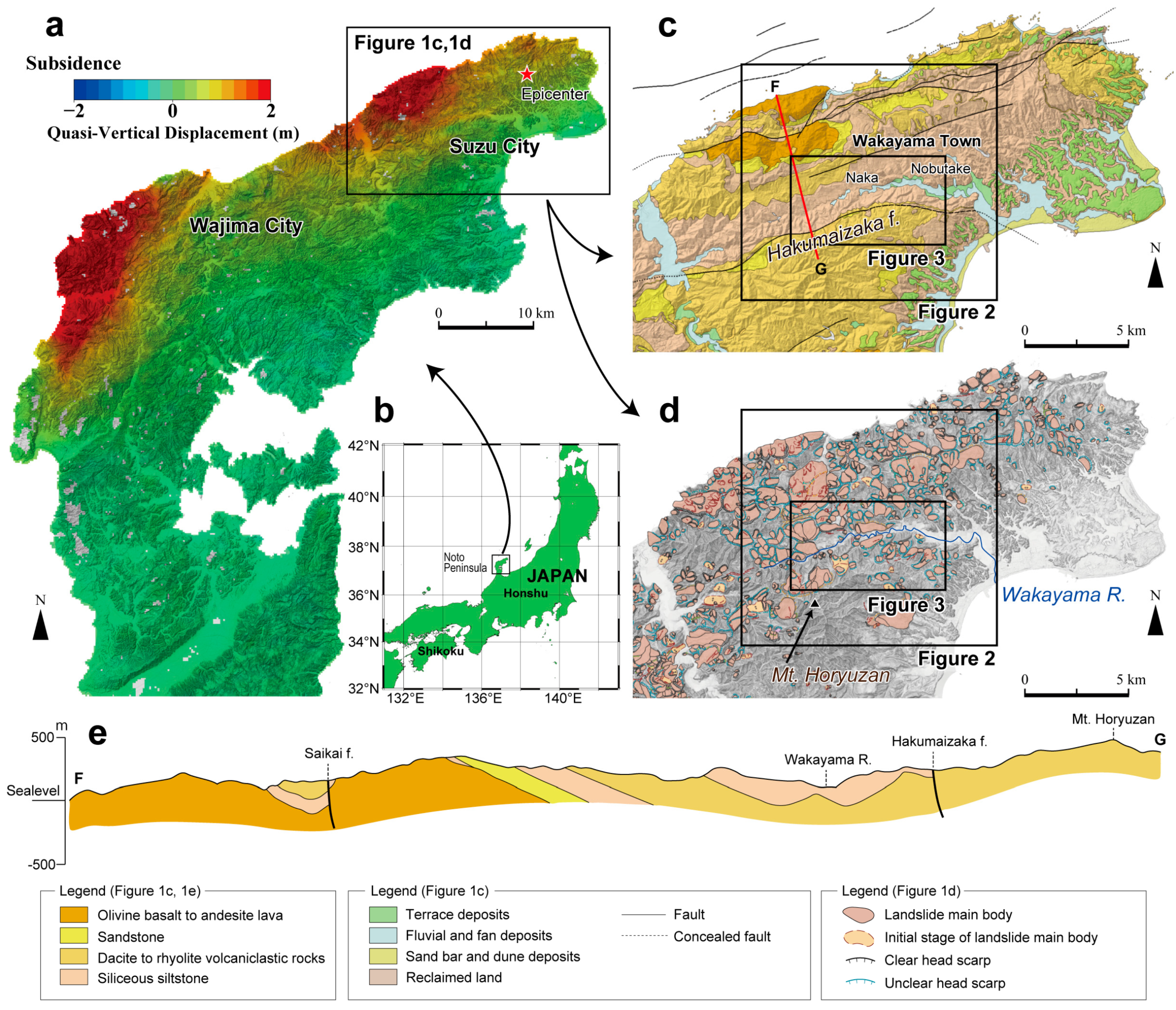
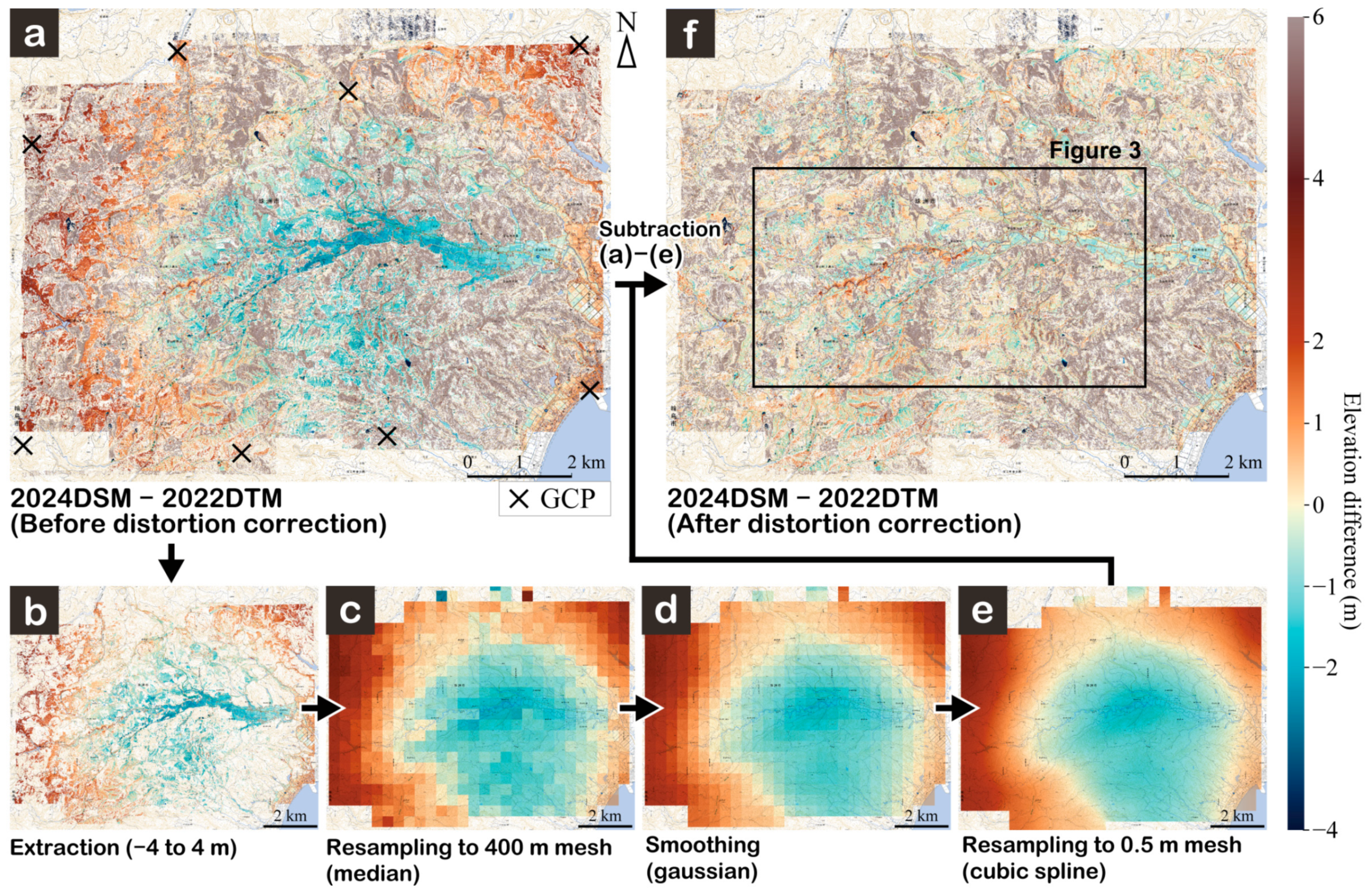

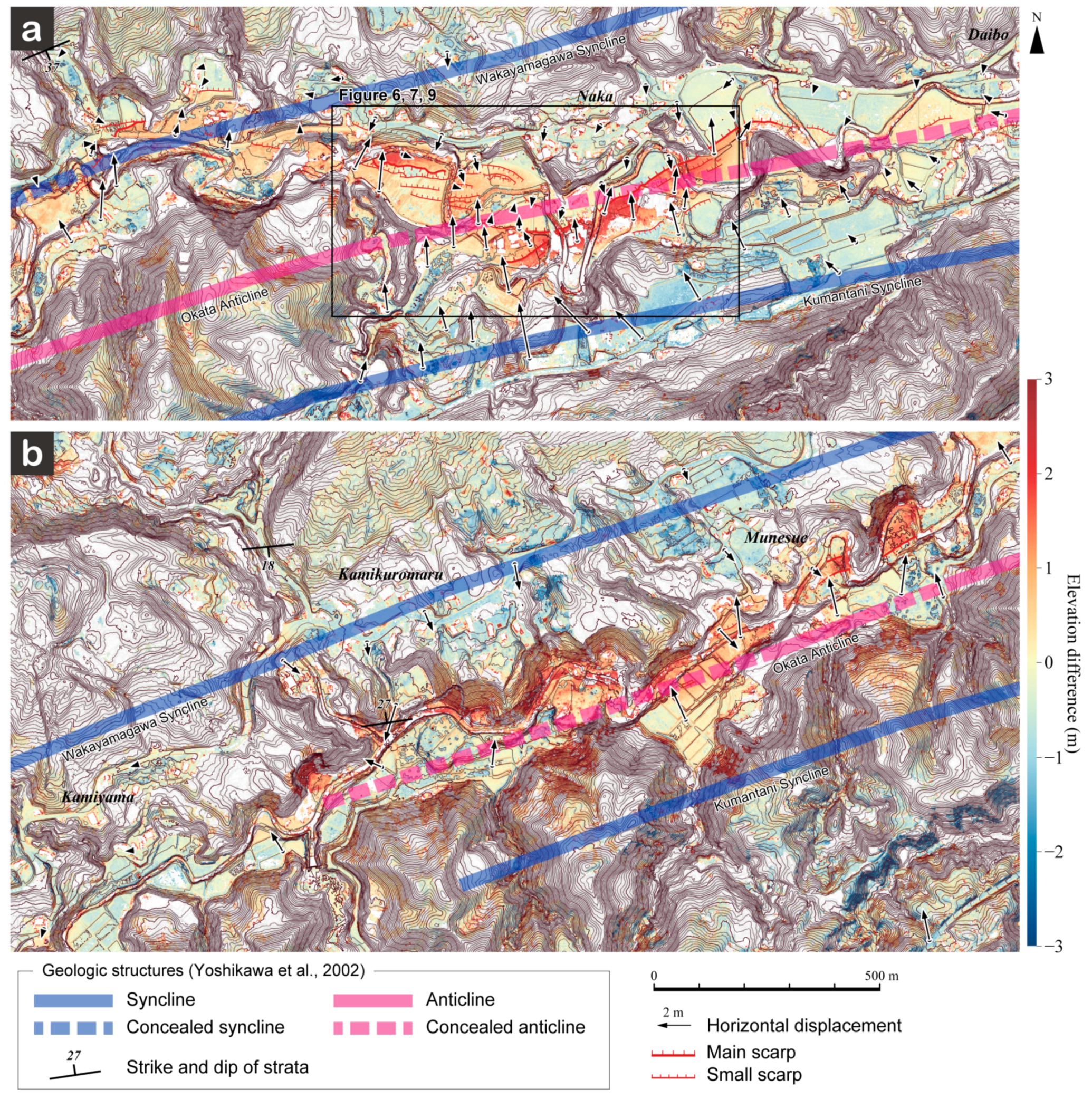
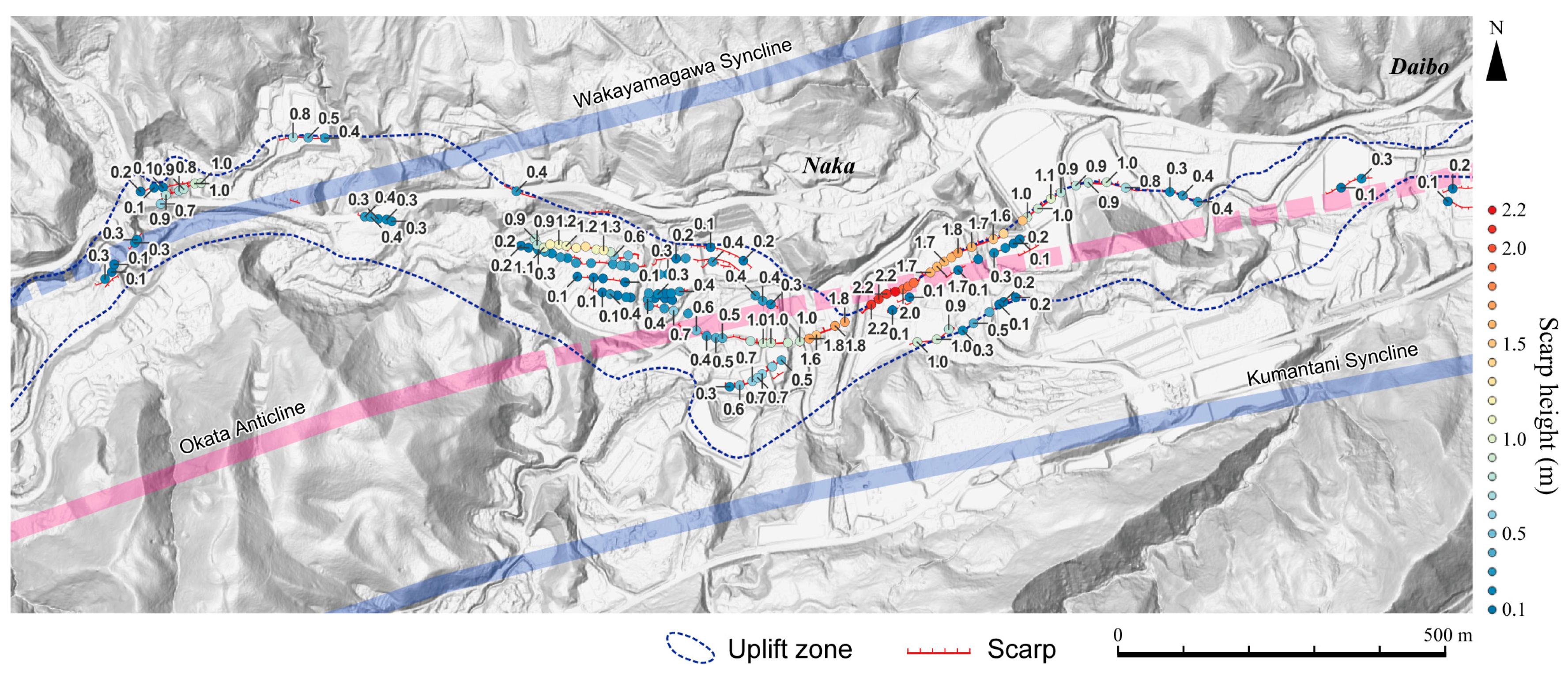
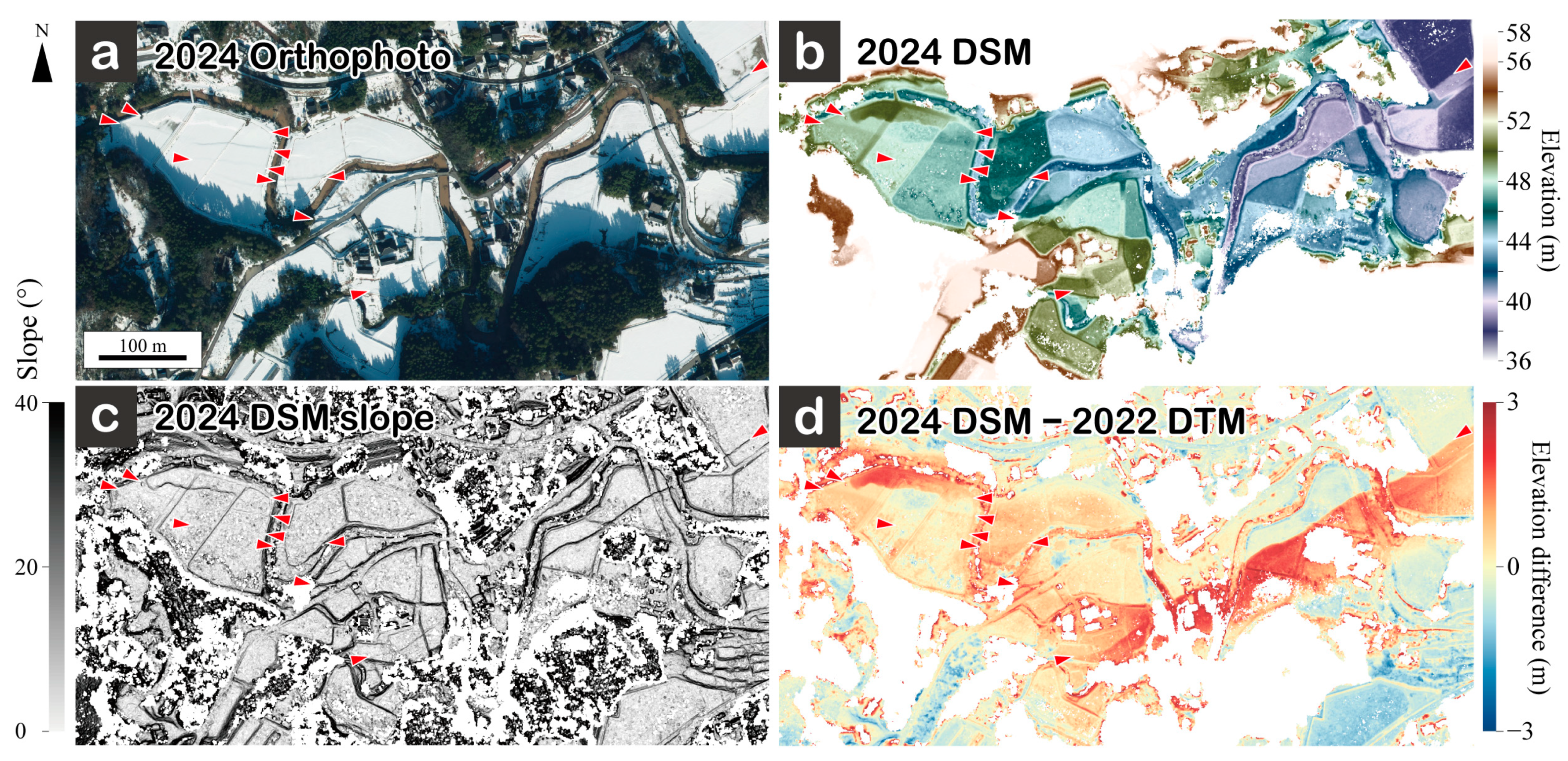
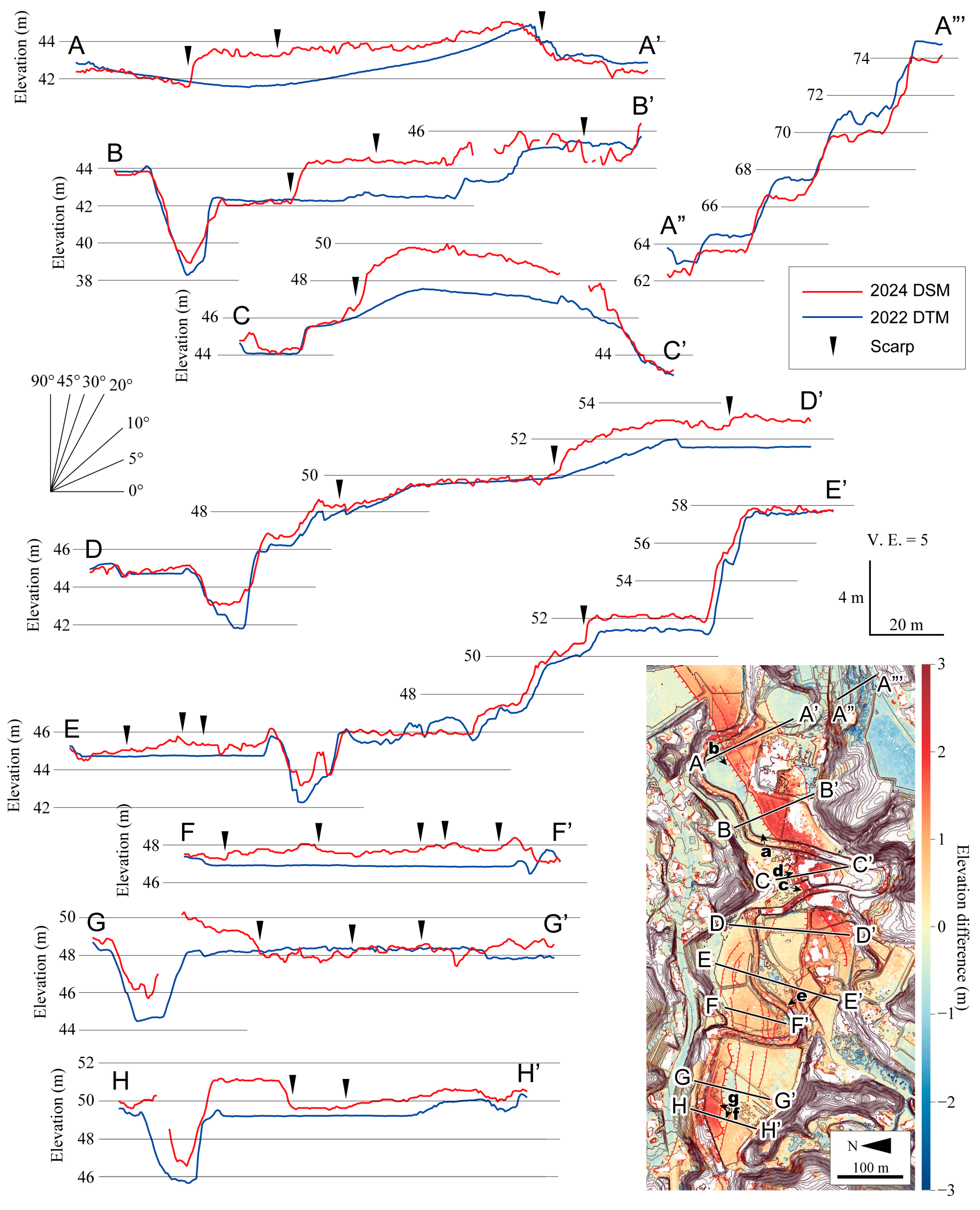
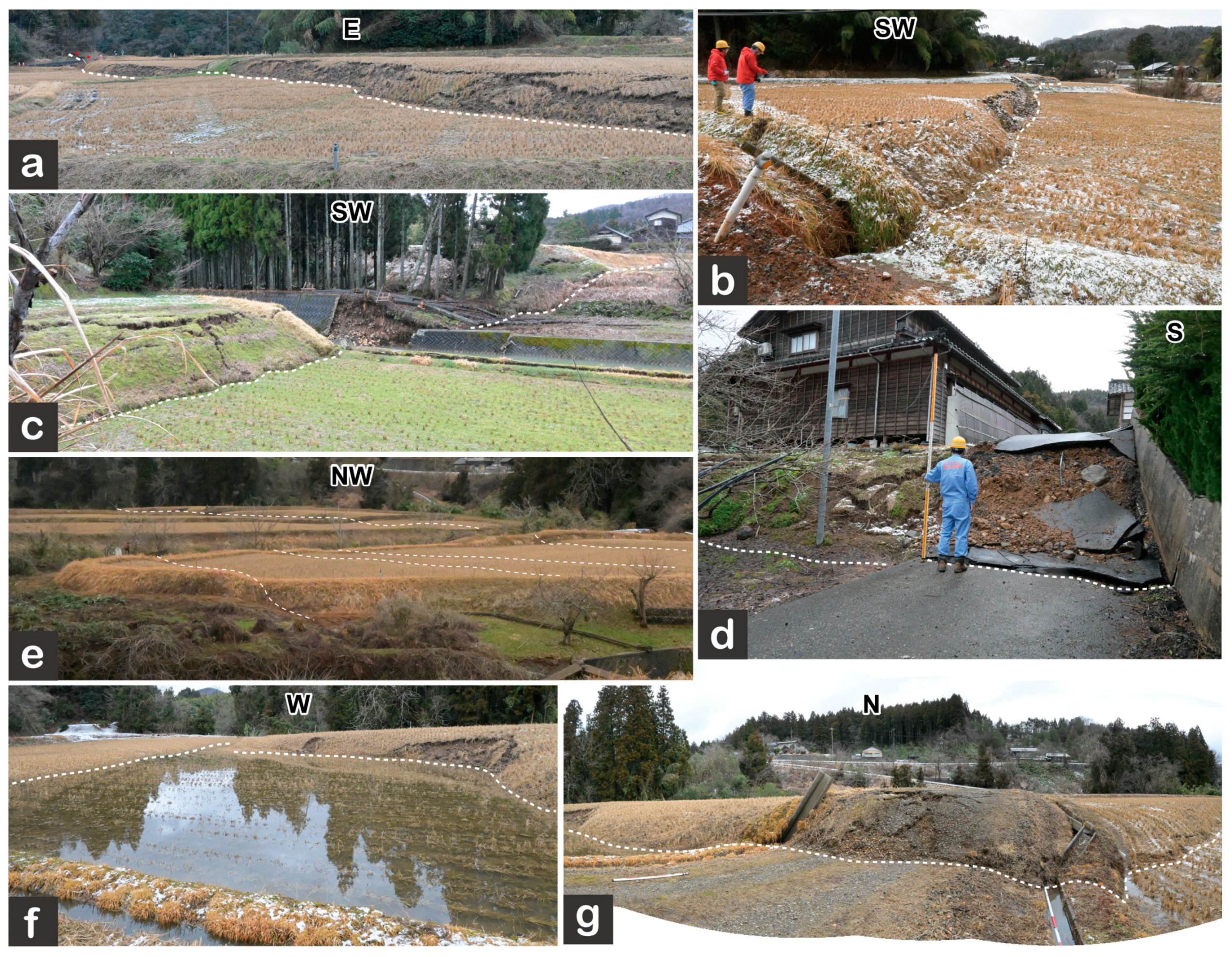
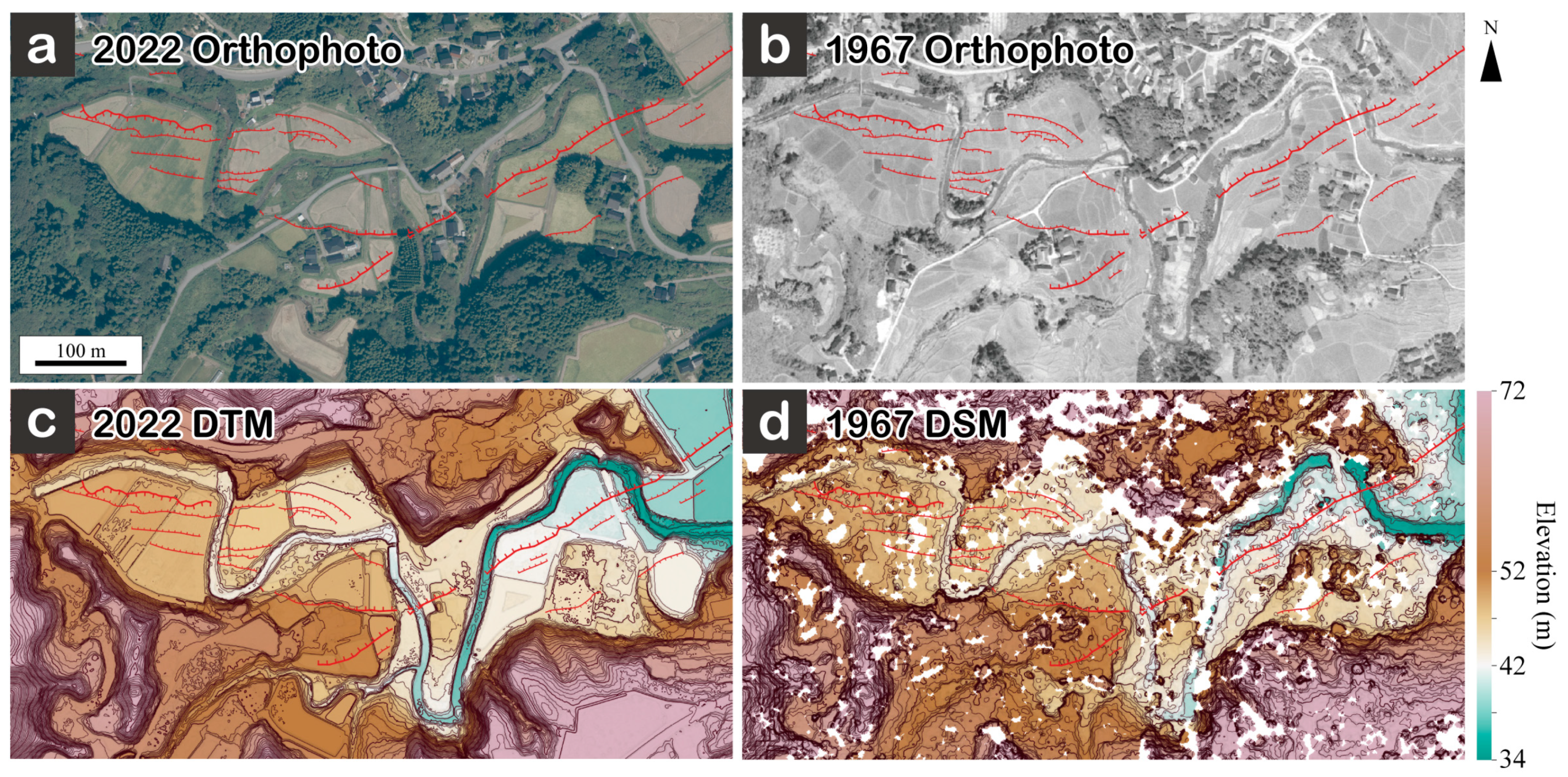
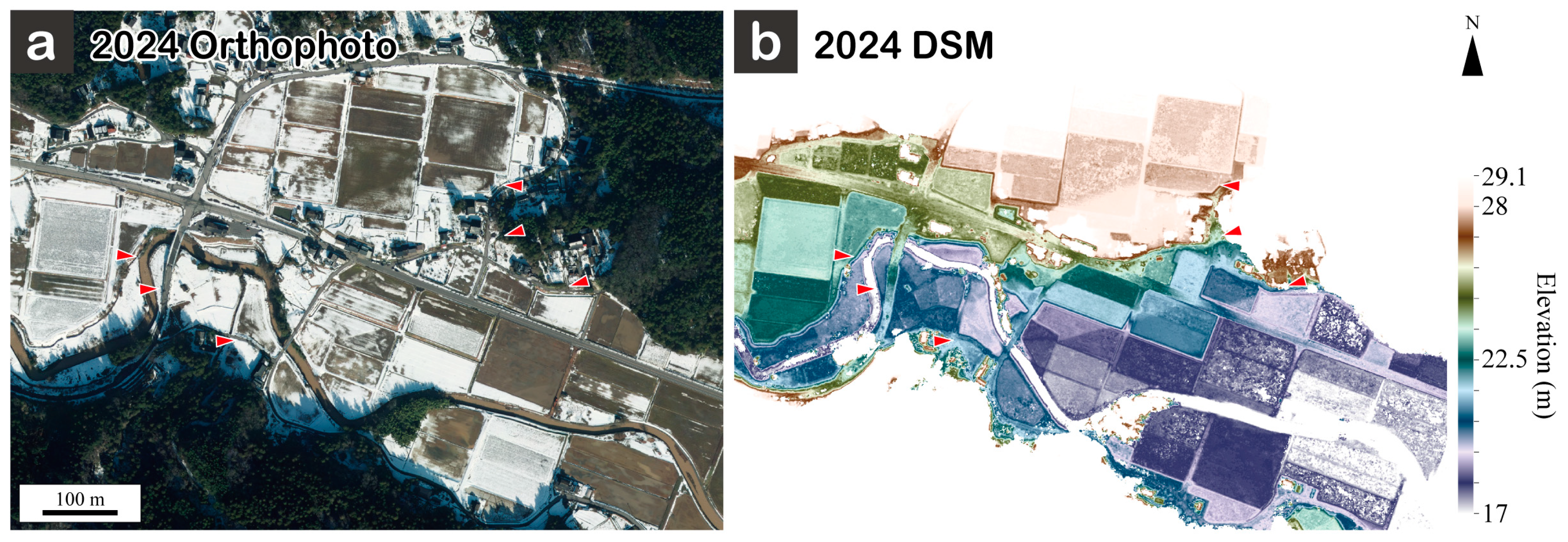
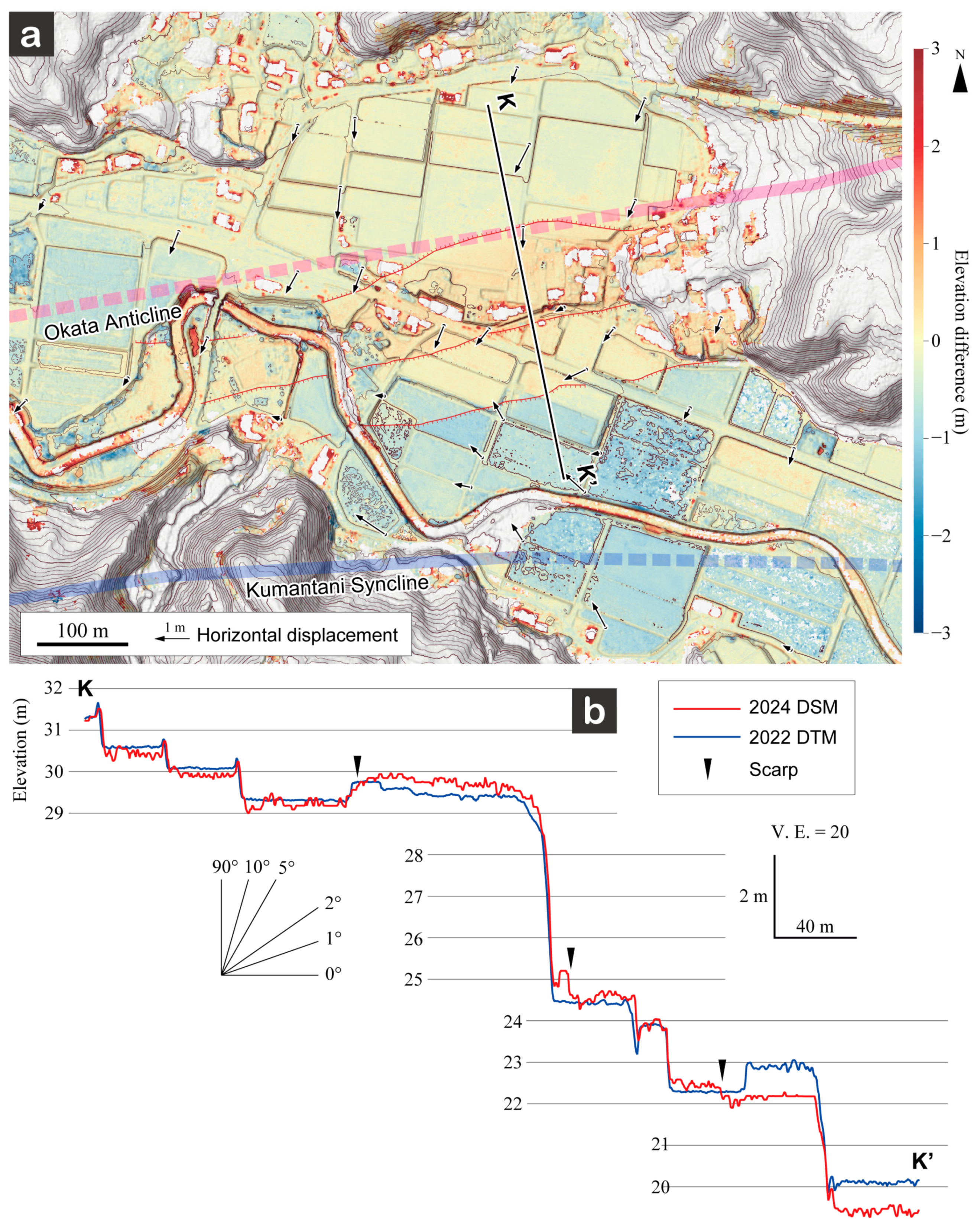
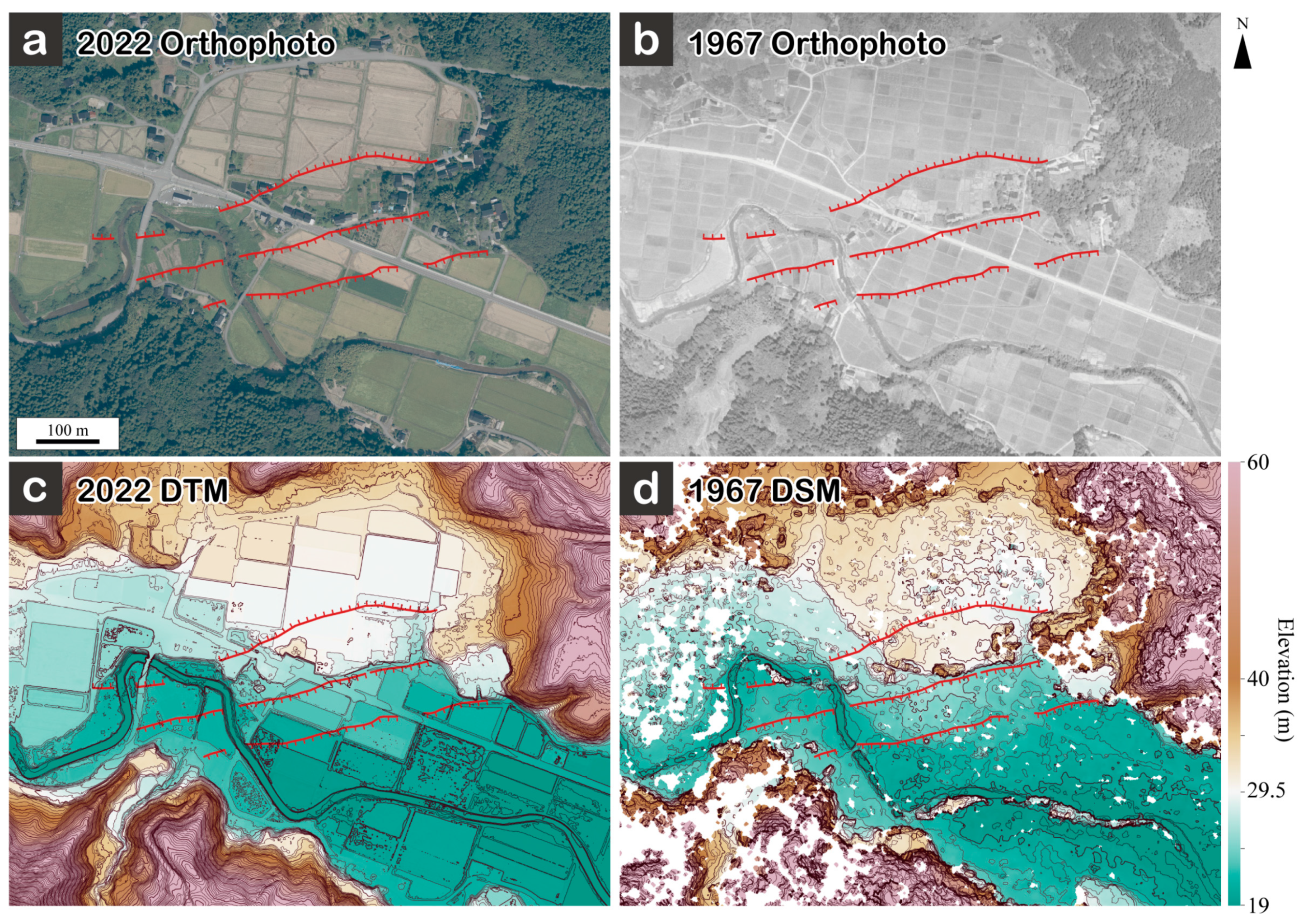
| Alignment/Reconstruction | Parameter | Setting |
|---|---|---|
| Point-cloud-alignment parameters | Accuracy | High |
| Generic preselection | No | |
| Reference preselection | Estimated | |
| Key point limit | 200,000 | |
| Tie point limit | 4000 | |
| Adaptive camera model fitting | Yes | |
| Depth-map-generation parameters | Quality | High |
| Filtering mode | Aggressive |
Disclaimer/Publisher’s Note: The statements, opinions and data contained in all publications are solely those of the individual author(s) and contributor(s) and not of MDPI and/or the editor(s). MDPI and/or the editor(s) disclaim responsibility for any injury to people or property resulting from any ideas, methods, instructions or products referred to in the content. |
© 2024 by the authors. Licensee MDPI, Basel, Switzerland. This article is an open access article distributed under the terms and conditions of the Creative Commons Attribution (CC BY) license (https://creativecommons.org/licenses/by/4.0/).
Share and Cite
Yoshida, K.; Endo, R.; Iwahashi, J.; Sasagawa, A.; Yarai, H. Aerial SfM–MVS Visualization of Surface Deformation along Folds during the 2024 Noto Peninsula Earthquake (Mw7.5). Remote Sens. 2024, 16, 2813. https://doi.org/10.3390/rs16152813
Yoshida K, Endo R, Iwahashi J, Sasagawa A, Yarai H. Aerial SfM–MVS Visualization of Surface Deformation along Folds during the 2024 Noto Peninsula Earthquake (Mw7.5). Remote Sensing. 2024; 16(15):2813. https://doi.org/10.3390/rs16152813
Chicago/Turabian StyleYoshida, Kazuki, Ryo Endo, Junko Iwahashi, Akira Sasagawa, and Hiroshi Yarai. 2024. "Aerial SfM–MVS Visualization of Surface Deformation along Folds during the 2024 Noto Peninsula Earthquake (Mw7.5)" Remote Sensing 16, no. 15: 2813. https://doi.org/10.3390/rs16152813





